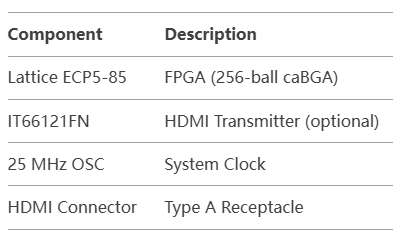Here's a comprehensive Lattice FPGA HDMI Transmission Scheme design using low-power Lattice FPGAs (e.g., ECP5 or CrossLink-NX). This solution covers hardware, FPGA logic, and software components for robust HDMI signal transmission:
1. System Overview
Target Devices: Lattice ECP5 (for cost-sensitive designs) or CrossLink-NX (for embedded MIPI DSI/CSI-to-HDMI bridging)
HDMI Version: 1.4b (Supports 1080p60, with optional TMDS scrambling for EMI reduction)
Key Features:
- TMDS Signal Generation (FPGA-native or external PHY)
- EDID Management (Hot-Plug Detect, DDC I2C)
- Color Space Conversion (RGB ↔ YCbCr 4:4:4)
- Audio Embedding (I2S to HDMI Audio Packet)
2. Hardware Design
A. Block Diagram
[Video Source] → [Lattice FPGA] → [HDMI Transmitter] → [HDMI Connector]
(ECP5/CrossLink) (e.g., IT66121 or native TMDS)
B. Critical Components
- FPGA Selection:
- ECP5-85F (For 1080p60 with internal LVDS→TMDS conversion)
- CrossLink-NX-17 (For MIPI DSI/CSI to HDMI conversion)
- HDMI PHY Options:
- Internal TMDS (ECP5 LVDS pins + SERDES)
- External PHY (e.g., IT66121 for simplified design)
- Clock Architecture:
- 148.5 MHz for 1080p60 (Pixel Clock)
- 27 MHz for I2C/EDID management
- Optional PLL for audio clock (e.g., 12.288 MHz for 48kHz audio)
- Connectors:
- HDMI Type A (Standard 19-pin)
- ESD Protection (TVS diodes on TMDS lines)
3. FPGA Logic Design (Verilog/VHDL)
A. TMDS Encoder Core
verilog
module tmds_encoder (
input clk_pixel,
input [7:0] data,
input [1:0] control,
output [9:0] tmds
);
// Implement DVI 1.0 Spec TMDS encoding
// Includes XOR/XNOR reduction and DC balancing
endmodule
B. Video Timing Controller
verilog
module video_timing (
output [11:0] h_count,
output [11:0] v_count,
output h_sync, v_sync, data_enable
);
// Generates 1080p60 timing:
// Active: 1920x1080, Front Porch/Sync/Back Porch
endmodule
C. I2C EDID Handler
verilog
module edid_reader (
inout sda,
output scl,
input hpd,
output [7:0] edid_data
);
// Responds to DDC requests and serves EDID
// Implements I2C slave at address 0x50
endmodule
4. Software Components
A. Lattice Diamond/Primary Configuration
- Pin Constraints (.lpf file for ECP5):
LOCATE COMP "tmds_clk_p" SITE "E4";
IO_TYPE "LVDS25";
- PLL Configuration:
- Generate 148.5 MHz from 25 MHz oscillator
- Phase-align TMDS clock/data
B. Embedded RISC-V Core (For Smart HDMI)
Use Lattice Propel to add soft-core CPU for:
- EDID parsing
- Dynamic resolution switching
- Audio packet generation
5. Signal Integrity Considerations
- PCB Layout Rules:
- TMDS Differential Pairs: 100Ω impedance, length-matched (±50mil)
- Layer Stackup: Route on adjacent layers with ground plane
- Termination: On-die termination (ODT) in ECP5
- EMI Reduction:
- Enable TMDS scrambling (HDMI 1.3+)
- Spread-spectrum clocking (if supported by sink)
6. Testing & Validation
- Test Pattern Generator:
Implement color bars/ramp in FPGA logic
verilog
case (h_count[3:0])
0: {r,g,b} = 8'hFF; // White
1: {r,g,b} = 8'h00; // Black
// ... Color pattern
endcase
- Compliance Testing:
Use HDMI analyzer (e.g., Quantum Data)
Verify:
- TMDS eye diagram
- EDID response time (<200ms)
- Hot-plug detection
7. Example Implementation (ECP5-85F)
Bill of Materials
Resource Utilization (Estimate)
- Logic Cells: ~5k LUTs (for 1080p60)
- Memory: 2x SPRAM (for line buffering)
- PLLs: 1 (for pixel clock generation)
8. Advanced Features (Optional)
- HDCP Encryption:
- Requires licensed IP core
- CrossLink-NX supports hard-IP HDCP 1.4
- 4K Support:
- Use ECP5-85F with external TMDS buffer
- Requires dual-link HDMI or switch to DisplayPort
- Embedded Audio:
verilog
audio_packetizer u_audio (
.i2s_data(audio_data),
.hdmi_header(audio_header),
.data_island(packet_data)
);
Debugging Tips
- No Signal?:
- Check HPD (Hot Plug Detect) pull-up
- Verify DDC I2C communication with logic analyzer
- Sparkles/Garbled Image:
- Recheck SERDES alignment
- Validate TMDS termination
- Use Lattice Reveal:
tcl
reveal_insert -port h_sync -name h_sync_debug
reveal_trigger -condition {h_count == 0}
This design balances cost, performance, and flexibility. For production designs, consider Lattice's HDMI IP核 or Reference Designs (like the ECP5 Video Interface Kit).




Top comments (0)